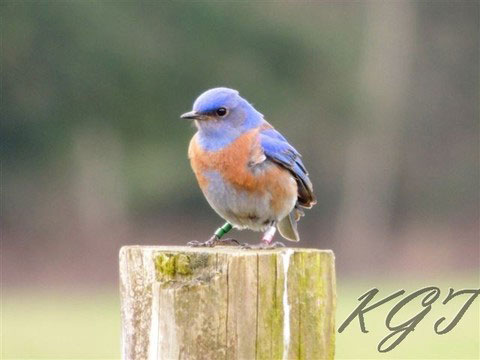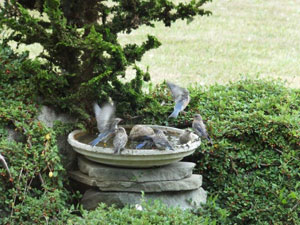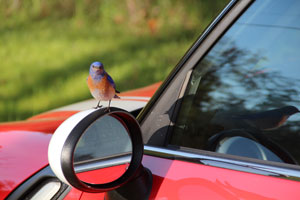
This male, hatched on San Juan Island last year, flew to Chilliwack BC earlier this spring.
2013 marks the 2nd year of post-reintroduction monitoring and our 7th field season on the project. It was an interesting year, full of highs and lows.
Here is a quick summary:
–(A low): 14 Western Bluebirds returned to SJI this year, a marked decrease from the returns in 2012 (34).
— (A high): We had nearly 100% survival rate of nestlings: all birds who hatched survived to fledging, with one exception.
–(A low): 24 nestlings were banded this year, down from 44 in 2012.
–(A high): One of our young females, hatched on SJI last year, flew to Vancouver Island and mated with a male there; the first recorded natural dispersal of these birds since the project began; a male (pictured above) also migrated to Canada.
–(A high): A female from the Ft. Lewis prairie made her way to SJI and mated with a male here, in another demonstration of natural dispersion.
–(A low): Both naturally dispersing females disappeared before young could be raised.
We well recognize that embarking on a project such as this will result in regular triumphs and frustrations. Our plan is to continue the post-reintroduction monitoring of our tenuous population to see if additional measures to augment it will be necessary. Stay tuned!

Bluebird fledglings delight in a fresh bath on San Juan Island (photo courtesy of Gigi Zakula).
Fall Bluebird Movement
A common question we get asked is “Where do the bluebirds go in the winter months?”
Our typical response is…”We don’t exactly know.” We do know that usually they depart San Juan Island in October/November (depending on weather conditions). We had a suspected sighting of one of the San Juan population in the Willamette Valley in Oregon this past winter; its possible more go further south, or some may stay close by, potentially on Whidbey Island. Regardless, they aren’t flying as far south as some of the southern populations of Westerns, as they do return quickly; sometimes as early as February.
Now is a good time to look for fall flocking activity, especially on the American Camp prairie and Eagle Cove, False & Kanaka Bay areas.
As always, sighting reports (especially during this time of year, where we are trying to track surviving juveniles) are greatly appreciated.
You may reach Kathleen on her cell phone at 360-298-1856 to report sighting info.

This unbanded male reached San Juan Island this spring…his origins unknown. He took a special interest in attacking car windows!
